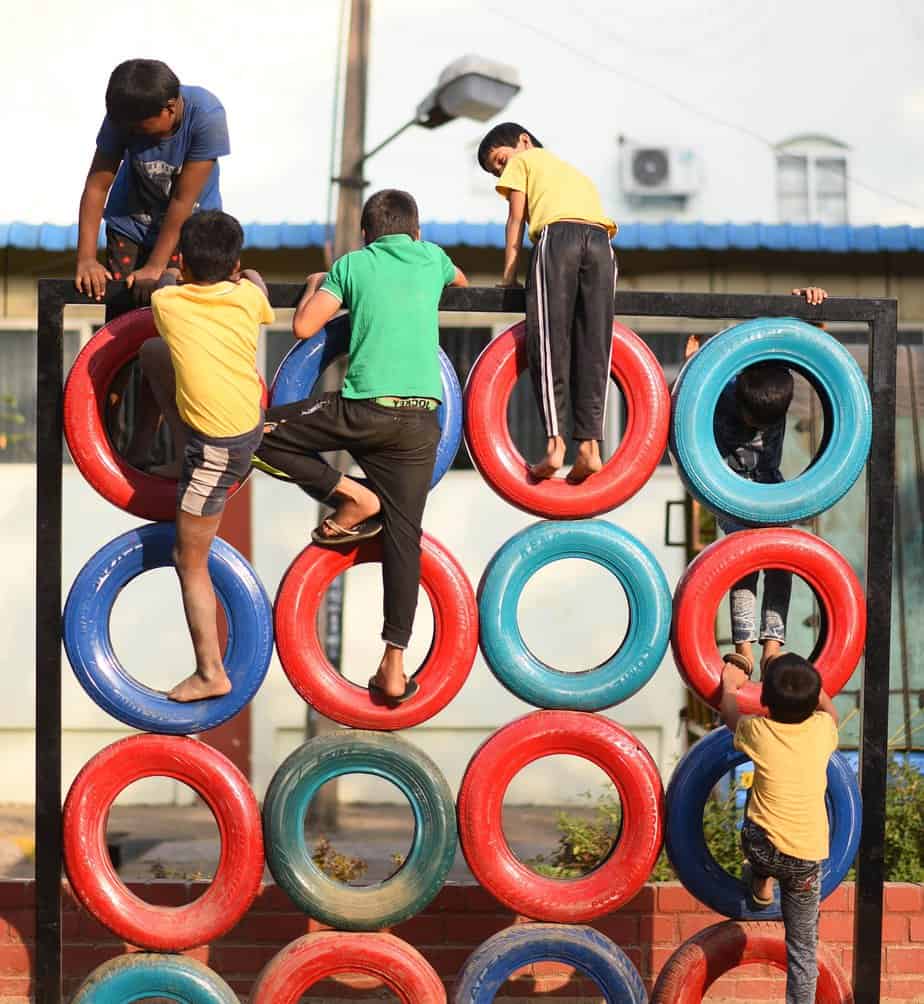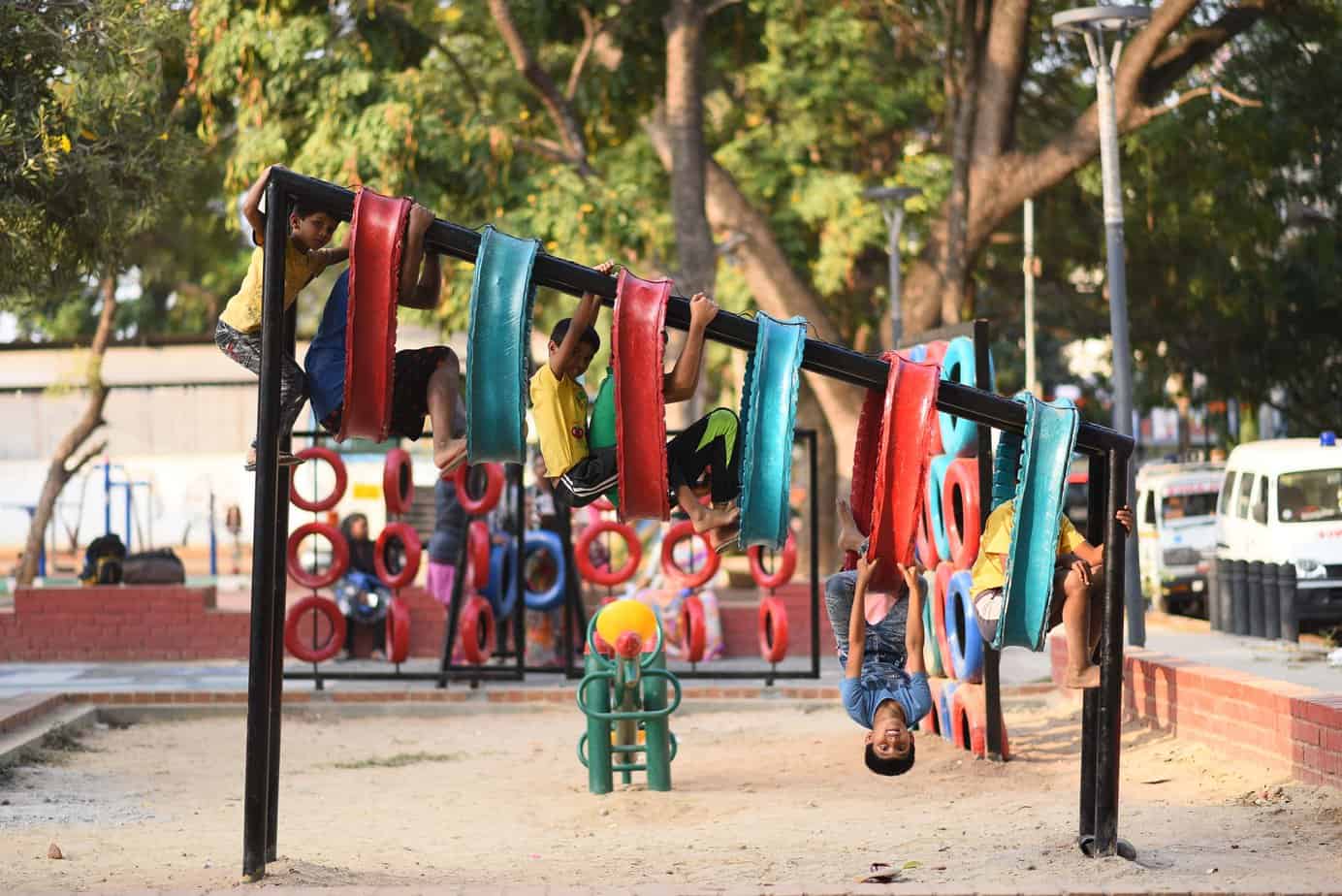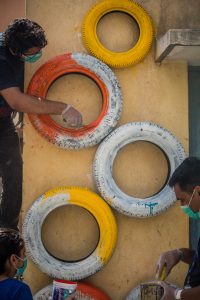Rusty swings and broken see-saws once ruled the playground in KSGMPS aka Immadihalli Government School in Whitefield, established during British rule. But since 2017, children are heading to the school playground earlier and leaving later, just so they can play with swings, caterpillars and twisters. Anthill Creations had set up these structures here using scrap tyres, a trademark of this Bengaluru-based non-profit.
In another part of the city is Aralikatte Park, near National College in Basavanagudi, also set up by Anthill. The monkey bar-like structure here has colourful tyres overhead, instead of the usual metal bars. Children clamber through and hang from the tyres, inventing their own games. There is also a wall made of tyres here, onto which children climb, trying to race each other. Or, they throw stones at it from afar, trying to get as many stones through the tyres as they can.

At Aralikatte Park. Pic: Anthill Creations
“Play is very important for children in the growing years. Many initiatives are happening inside classes, but there is so much that the child learns outside class,” says Pooja Rai, Co-founder of Anthill Creations.
According to a 2016 survey, children in India have fewer opportunities to play outdoors than their parents had as children. The study had found that globally, over half the children play outside for just one hour or lesser every day.
Playgrounds essential, but shrinking
“Play is everything in a child’s life. When we look at developmental milestones in childhood, everything that the child learns – motor skills, cognitive skills, logical thinking, speech, socialisation – comes from play,” says Dr Angela David, a developmental paediatrician based in Bengaluru.
Dr Angela believes the primary reason children aren’t getting enough outdoor play is the lack of spaces that are available, accessible and well-maintained. A 2017 study on open spaces by the NGO Janaagraha had found that, of the 1115 parks and 192 playgrounds in Bengaluru, less than 40 percent had play equipment.
Building with scraps
Launched in 2015, Anthill Creations is a team of just 12, including five architects. This small team has set up 75 playgrounds in cities, villages, tribal areas and refugee communities across 16 states in India, to get more children to play. As per Anthill’s data, these playgrounds have impacted roughly 10,000 children.
These ‘play scapes’, as they like to call their parks, are largely made of locally-sourced waste materials, mostly scrap tyres that otherwise get dumped in landfills or are burnt releasing toxins into the environment. Scrap materials also bring down expenses significantly. Pooja estimates that the cost of building one of their play scapes is only one-third that of building a traditional metal park of the same size.
On average, 70-80 scrap tyres are used to create a play scape. The repurposed, colourfully-painted tyres were what struck Rekha Jain, a resident in the neighbourhood, when she first saw Aralikatte Park. Earlier, this site was a dumping ground for discarded metro rail construction materials and household waste.
Rekha now brings her two young daughters to the park. “I’m not a big fan of giving my kids gadgets. I spent my childhood playing a lot of outdoor and indoor games. I prefer the same for my kids, so that they get exposed to the world outside, learn and become independent,” she says.

Aralikatte Park. Pic: Anthill Creations
In addition to tyres, Anthill also tries to use different materials according to availability and circumstances. For example, the organisation stepped in after the Gaja cyclone in Tamil Nadu that had led thousands of coconut trees to fall. “There we are using fallen trees, because people are burning these as they don’t have the money to transport it. So using locally-available material – whatever resources are available – is the key to what we are doing,” says Pooja.
Free play scapes for government schools
Realising the need for low-cost playgrounds in government schools, Anthill had approached schools earlier. In turn, some 100 schools across India have come forward, requesting them to set up play scapes.
Once Anthill identifies a school or public space that needs a playground, they send a team to scope out the area, or send a site survey form to the community they are collaborating with. The survey helps Anthill get site measurements and other information like age-group of the children who would use the park, and whether the area is prone to vandalism or earthquake. Accordingly, the playground is designed and its budget set.
G Sarojamma, Headmistress at Govindarajanagar Government School, had welcomed the idea of a playground in their campus as the school administration didn’t have to bear any cost. Kids throng the play area during breaks, inventing games around the structures made out of tyres.

The playground at Govindarajanagar Government School. Pic: Anthill Creations
Shoaib, 9, seems to enjoy jumping on the tyres around a metal pole, which he sometimes climbs up to sit on top. “Children have to make up their own games, their own rules, their own way of doing things. That definitely brings out a lot of their cognitive and logical thinking,” Dr Angela observes.
Though Anthill incorporates traditional play equipment like swings, many of their designs are abstract and don’t quite give away how the structure can be played with. “Children tend to improvise and find alternative uses. When an object is not known to them, they might experiment and try to invent uses for it,” says Murali Krishna, an architect specialised in game and toy design, who currently teaches at the Srishti Institute of Art, Design and Technology.
Nithasha P K had collaborated with Anthill to build a playground in KSGMPS when she was a Teach for India (TFI) Fellow at the school. Once the structures were built, TFI Fellows realised that the components of some of the play structures could be used as teaching aids. “There was a column of tyres, and the kids would go up and come down those – either from the inside or outside. My co-fellow used it to teach them some geometry and geometrical patterns,” says Nithasha.
Funds to build the play scape is either raised by the beneficiaries themselves, or Anthill collaborates with companies that can assist with funds, manpower, or waste materials like tyres and oil drums. The playgrounds can be easily set up in five days. Since the process is simple, Anthill is now trying to scale up their model by making their designs DIY-friendly and encouraging communities to build play scapes themselves.

Anthill team at work. Pic: Anthill Creations
Most of the equipment, being made of tyres, don’t rust over time unlike iron play equipment. Nevertheless, Anthill follows up the first three months to ensure the parks are in good condition, and then hands it over to the community while still being available for assistance when required. But, long-term maintenance of the parks isn’t without hurdles.
“The tyres become very slippery during monsoon and water collects in them, and suddenly there are so many mosquitoes,” Sarojamma points out. Tackling this means extra supervision of play and equipment maintenance during monsoons, but the school headmistress believes that this is something any park demands.
Biggest hurdle is changing mindsets
“Earlier, the understanding was that you let children play so that they stay engaged. Later on, when people started studying play more deeply, they understood that it is not a random activity,” says Krishna. Many people across the world have come to realise this, and are pushing for children to grow up with active, creative play in their lives.
In the process, playground design is diversifying and being experimented with. For instance, the USA-based Imagination Playground is a mobile block-based play system that comprises lightweight foam blocks of various shapes and sizes. This product allows children to create their own play spaces and objects.
In India, organisations like the Delhi-based Action for Children’s Environment are emphasising children’s right to play, especially those in crisis situations like refugees. They have also partnered with the international Outdoor Classroom Day campaign that encourages teachers to take lessons outdoors.
Anthill has brought play to many children, but they say their biggest challenge is changing mindsets – getting people to see the benefits and necessity of play. Though this is a slow process, the approach to play is changing gradually, as it is increasingly being associated with the development of essential skills in children.
GREAT IDEA….
Nice initiative! Hats off to the Anthill Creations team!
Keep it up team Anthill and thanks Sakshi for the great article